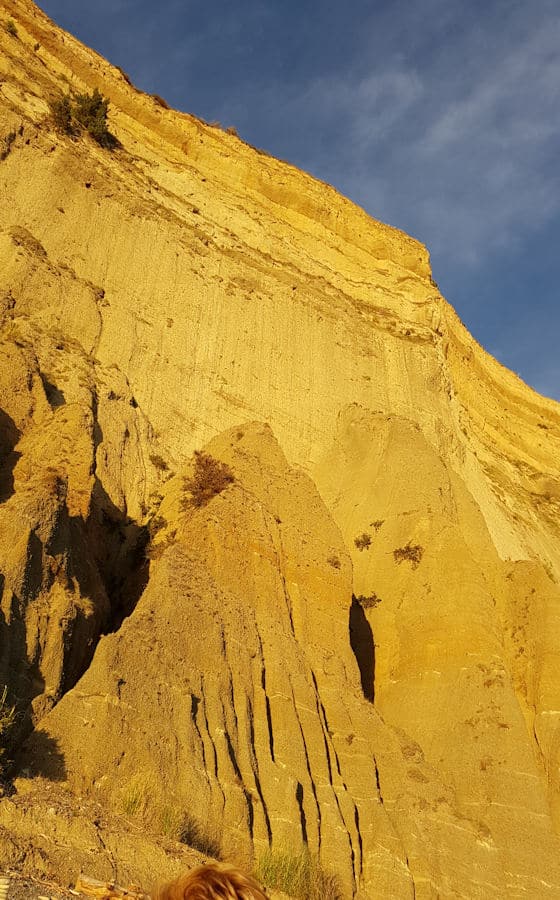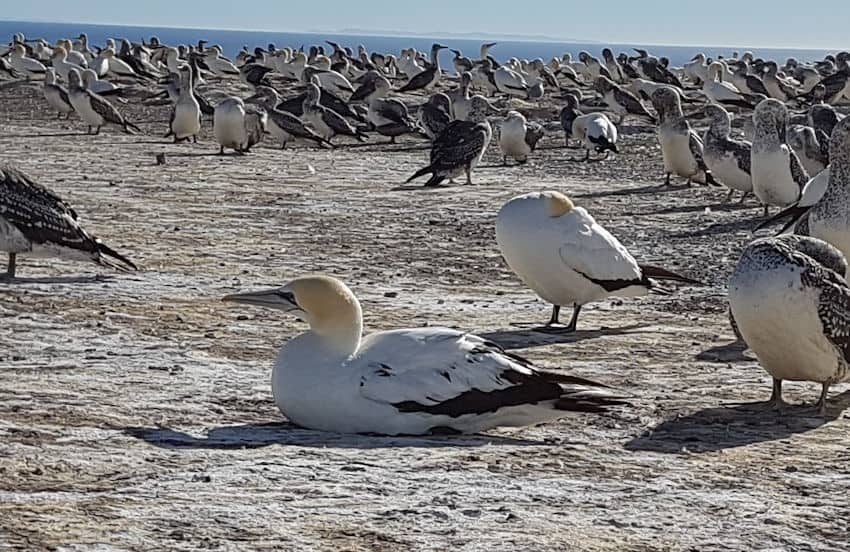Cape Kidnappers/Te Kauwae-a-Māui is situated at the eastern tip of the province of Hawke’s Bay. In Māori mythology, Te Kauwae-a-Māui is the tip of the fishing hook that Māui used to pull up the North Island/Te Ika-a-Māui (‘the fish of Māui’) from the sea.
In 1769 it was named “Cape Kidnappers” by Captain James Cook, the famous English explorer, when local Maori attempted to kidnap his ships interpreters’ son, a young Tahitian boy.

The coastline from Clifton to Cape Kidnappers has a very interesting geological history. Towering cliff faces show clear evidence of different layers of sedimentary material. Earthquake faultlines, gullies and fossils can be clearly seen as well as evidence of the slump of the land due to the tectonic movement. The track is also tidal so make sure you are aware not to be caught by the incoming water!
Cape Kidnappers is the largest mainland nesting site in the world and accommodates almost 25,000 gannets at its peak with approximately 5,000 breeding pairs.
These gannets are the Australasian Takapu gannet. With a 1.8 m wing-span this bird is predominantly white with pointed wings, a long neck and slender body. With black on the trailing edges of it’s wings and within it’s tail feathers, a bluish-grey bill with a black lining and deep blue around the eyes they are distinctive and very elegant looking birds.
There are 4 main nesting sites at Cape Kidnappers being the Plateau, Black Reef, Saddle and Whalebone Reef and you can spot the gannets in high numbers from August to April each year.
The gannets were not mentioned by Captain James Cook on his travels around New Zealand so it is presumed they arrived later. The first note of the gannets on this site was around 1850 by Henry Hill, a New Zealand naturalist.

Gannets impressively take their first flight at 15-16 weeks and it is a migration to Australia around 2,800 km. Those that survive, and the numbers are low with approximately 70-80% perishing before returning to NZ. This return is approximately 2-3 years later and after this return they remain at the colony for the rest of their lives, on the land during breeding and winter months out in the New Zealand waters.
The males return before the females and either re-occupy, establish and then defend a nest. Gannets tend to mate for life. Only one egg is laid although if that is lost a replacement egg may be laid.
So when you’re next in the area make a point of heading to see the gannets - a visit to Hawkes Bay just wouldn’t be the same without one!
Aotearoa is the Maori name for New Zealand, though it seems at first to have been used for the North Island only. Many meanings have been given for the name but with Maori names the true meaning can often be found only in a mythological story or in historical fiction illustrating either how the name was given or something of the ideas which prompted it. Aotearoa is made up of either two or three words, Aotea and roa or Ao tea and roa. Aotea could be the name of one of the canoes of the great migration, the great magellan cloud near the bright star Canopus in summer, a bird or even food; ao is a cloud, dawn, daytime, or world; tea white or clear, perhaps bright, while roa means long or tall.
The most popular and authoritative meaning usually given is “long white cloud”, and there are two stories current to illustrate this. It seems the voyagers to New Zealand were guided during the day by a long white cloud and at night by a long bright cloud. The more usual one tells how, when Kupe was nearing land after his long voyage, the first sign of land was the peculiar cloud hanging over it. Kupe drew attention to it and said “Surely is a point of land”. His wife, Hine-te-aparangi, called out “He ao! He ao!” (a cloud! a cloud!) Later Kupe decided to call the land after his wife's greeting to it, and the cloud which welcomed them. The name Aotea was given both to the Great Barrier and to the North Island, but the latter became Aotearoa, presumably because of its length.
According to certain authorities, the other meanings are: big glaring light (Hochstetter); continuously clear light, or land of abiding day (Stowell); long white world (Wilson); long bright world, long daylight, long lingering day, or long bright land (Cowan); and long bright day (Tregear). A good case could probably be made out for the land of abiding day, or similar names. Maui, who is closely connected with New Zealand in mythology, once snared the sun and beat him to make him travel more slowly across the sky. Perhaps Maui achieved the same end when he sailed south to fish up New Zealand where there is longer day with long twilight, particularly in the south.
'AOTEAROA', from An Encyclopaedia of New Zealand, edited by A. H. McLintock, originally published in 1966.
Te Ara - the Encyclopedia of New Zealand
URL: http://www.TeAra.govt.nz/en/1966/aotearoa (accessed 06 Jan 2021)
With domestic travel currently the only wise activity within Covid restrictions, our local tourism industry could really do with the support so Linku2 are featuring on a number of articles to help you pick what would suit you and your family to get out and enjoy our beautiful country!
100% Pure New Zealand have some great articles to give you great ideas such as their North Island Must Do Experiences including our amazing Pouakai Crossing, stunning Cathedral Cove, Rotorua's geothermal spectacles and lots more. Check these out and enjoy every single one of them! NZ.com top North Island Activities ...
Visiting Hawke’s Bay for the school holidays? You’ve come to the right place as there are plenty of family-friendly activities on offer.
Here are just a few boredom-busters that will keep the kids entertained for ages.
Brought to you by hawkesbaynz.com
Has your child ever asked you this question? And what was your answer? Here are a few facts and arguments you can use in the future.
When learning many can't understand the benefits of maths beyond the basic calculation of daily things. However maths is important in all aspects of our lives.
Maths equips us with many tools including -
· Logical reasoning
· Ability to think in abstract ways
· Problem solving skills
Maths develops the imagination and trains us to be able to think clearly. Maths is also important in the development of language. You would be amazed at how often the language of maths crops up in your daily conversations; talking about time, money, temperature, technology, planning trips, shopping, cooking, designing plans ...
Mathematics is important in many everyday employment situations, science and technology, medicine, the economy, the environment and development, and in public decision-making. Think of the jobs that require maths these include doctors, teachers, scientists, engineers, technology services, lawyers, marketing, building, designers just to name a few.
Maths is invariably used, and often without realisation, to find the right concepts and methods to make difficult things easy, to explaining why a situation is how it is. By using maths skills you develop language and insights into our understanding and appreciation of the world.
Maths isn't just numbers and is all about patterns too. Imagine a fashion designer trying to develop a concept without maths abilities!
Increasingly, employers are looking for graduates with strong skills in reasoning and problem solving.
Finally of course everyone nowadays has a computer. The computer itself is a machine built upon the principles of mathematics.
So whilst you may think you don't use maths or hate the subject, just imagine how you would get on calculating your change at the shop, working out if you can afford that much anticipated trip, reading your bank statement or baking that cake if you had no, or very limited, concept and knowledge of that often dreaded subject - mathematics!